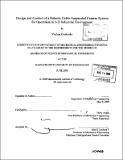| dc.contributor.advisor | Harry Asada. | en_US |
| dc.contributor.author | Gordievsky, Vladimir | en_US |
| dc.contributor.other | Massachusetts Institute of Technology. Dept. of Mechanical Engineering. | en_US |
| dc.date.accessioned | 2009-06-30T16:25:04Z | |
| dc.date.available | 2009-06-30T16:25:04Z | |
| dc.date.copyright | 2008 | en_US |
| dc.date.issued | 2008 | en_US |
| dc.identifier.uri | http://hdl.handle.net/1721.1/45844 | |
| dc.description | Thesis (S.B.)--Massachusetts Institute of Technology, Dept. of Mechanical Engineering, 2008. | en_US |
| dc.description | Includes bibliographical references (leaves 52-54). | en_US |
| dc.description.abstract | Cable-suspended robots offer many advantages over conventional serial manipulators. The main benefit of cable robots is their large workspace size, which makes them well suited for broadcasting, transporting/loading, and construction applications. Since cables can only pull and not push the end-effector however, designing and controlling cable robots becomes more challenging. This thesis describes the design of a three-cable underconstrained robot which was built and then tested using a velocity feedback loop with a built-in PI controller. The endeffector of the robot consists of a camcorder mounted on a platform. The objective of the robot is to manipulate the camcorder in 3-D space with minimal tracking error. The dynamic equations of the system are derived along with the kinematic relationships and a closed-loop controller is designed. The controller is tested by prescribing a trajectory to the end-effector. Simulink derives the motor velocities given the desired Cartesian positions of the end-effector and simultaneously controls all three motors. The results of the experiment show that the error in the trajectory, which is on the order of about seven centimeters in the x -y plane, is small compared to the size of the robot's workspace. However, depending on the required precision, improvements may have to be made to the robot to reduce error. Future research ideas are presented to expand the scope of the robot. | en_US |
| dc.description.statementofresponsibility | by Vladimir Gordievsky. | en_US |
| dc.format.extent | 54 leaves | en_US |
| dc.language.iso | eng | en_US |
| dc.publisher | Massachusetts Institute of Technology | en_US |
| dc.rights | M.I.T. theses are protected by
copyright. They may be viewed from this source for any purpose, but
reproduction or distribution in any format is prohibited without written
permission. See provided URL for inquiries about permission. | en_US |
| dc.rights.uri | http://dspace.mit.edu/handle/1721.1/7582 | en_US |
| dc.subject | Mechanical Engineering. | en_US |
| dc.title | Design and control of a robotic cable-suspended camera system for operation in 3-D industrial environment | en_US |
| dc.type | Thesis | en_US |
| dc.description.degree | S.B. | en_US |
| dc.contributor.department | Massachusetts Institute of Technology. Department of Mechanical Engineering | |
| dc.identifier.oclc | 319631953 | en_US |
